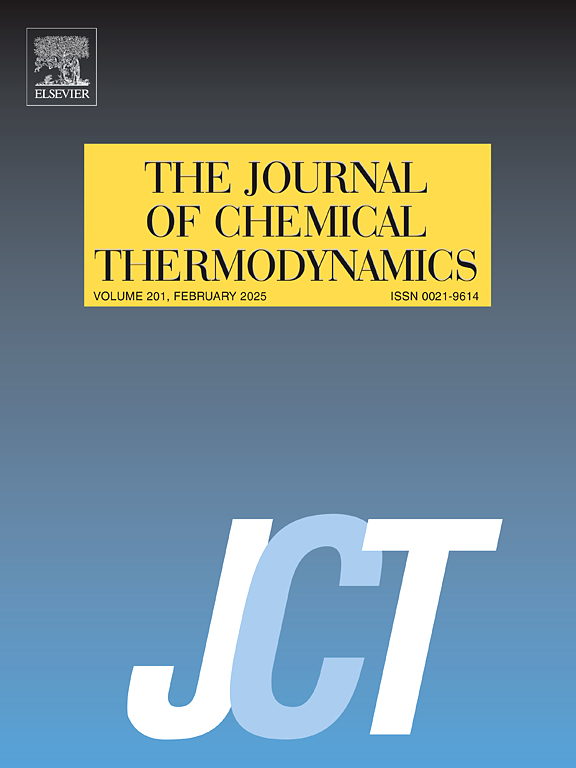不同温度下丙烯酸丁酯+ 1-丁醇、+ 2-丁醇、+ 2-甲基-1-丙醇、+ 2-甲基-2-丙醇体系分子相互作用的声学、粘度和光谱研究:实验和理论方法
IF 2.2
3区 工程技术
Q3 CHEMISTRY, PHYSICAL
引用次数: 0
摘要
在常温、常压(p = 100 kPa)条件下,测定了丙烯酸丁酯+1-丁醇/2-丁醇/2-甲基-1-丙醇/2-甲基-2-丙醇二元混合物在整个组成范围内的声速、u和粘度、η。利用测量数据,即超额等熵可压缩性、超额分子间自由长度、超额声速、超额摩尔等熵可压缩性、超额比声阻抗和粘度偏差进行了评估。组分在整个组成范围内的偏摩尔等熵可压缩性和超偏摩尔等熵可压缩性;在无限稀释下计算。这些参数的变化被解释为与这些混合物中的分子间相互作用有关。结果表明,丙烯酸丁酯与醇的相互作用程度依次为:1-丁醇>;2-丁醇>;2-甲基-1-丙醇>;2-甲基-2-丙醇。利用各种理论/关系对声速进行了理论计算,并用几个经验和半经验方程对这些混合物的粘度进行了关联,并与实验数据进行了比较。讨论了这些理论/关系的相对适用性。为了进一步确认主要的分子间相互作用的性质和程度,我们记录和分析了纯丙烯酸丁酯、异构体丁醇及其近等摩尔混合物的FT-IR光谱,以验证主要的相互作用。本文章由计算机程序翻译,如有差异,请以英文原文为准。

Acoustic, viscometric and spectroscopic study of molecular interactions in butyl acrylate + 1-butanol, + 2-butanol, + 2-methyl-1-propanol, + 2-methyl-2-propanol systems at different temperatures: Experimental and theoretical approach
The speeds of sound, u and viscosities, η of butyl acrylate +1-butanol/2-butanol/2-methyl-1-propanol/2-methyl-2-propanol binary mixtures across the entire composition range were measured at ambient temperatures and pressure, p = 100 kPa. Using the measured data, viz., excess isentropic compressibilities, excess intermolecular free lengths, excess speeds of sound, excess molar isentropic compressibilities, excess specific acoustic impedances and deviations in viscosity were evaluated. The partial molar isentropic compressibilities and excess partial molar isentropic compressibilities of the components over whole composition range; and at infinite dilution are calculated. The variation of these parameters has been interpreted in relations to intermolecular interactions in these mixtures. The results indicate that the extent of butyl acrylate-alkanol interactions follow the order: 1-butanol >2-butanol >2-methyl-1-propanol >2-methyl-2-propanol. The speeds of sound were theoretically calculated by means of various theories/relations and the viscosities of these mixtures were correlated by means of several empirical and semi-empirical equations and the outcomes are compared with experimental data. The relative applicability of these theories/relations has been discussed. Further to confirm the nature and extent of prevailing intermolecular interactions, the FT-IR spectra of pure butyl acrylate, isomeric butanols and their near equimolar mixtures were recorded and analyzed to validate the prevailing interactions.
求助全文
通过发布文献求助,成功后即可免费获取论文全文。
去求助
来源期刊

Journal of Chemical Thermodynamics
工程技术-热力学
CiteScore
5.60
自引率
15.40%
发文量
199
审稿时长
79 days
期刊介绍:
The Journal of Chemical Thermodynamics exists primarily for dissemination of significant new knowledge in experimental equilibrium thermodynamics and transport properties of chemical systems. The defining attributes of The Journal are the quality and relevance of the papers published.
The Journal publishes work relating to gases, liquids, solids, polymers, mixtures, solutions and interfaces. Studies on systems with variability, such as biological or bio-based materials, gas hydrates, among others, will also be considered provided these are well characterized and reproducible where possible. Experimental methods should be described in sufficient detail to allow critical assessment of the accuracy claimed.
Authors are encouraged to provide physical or chemical interpretations of the results. Articles can contain modelling sections providing representations of data or molecular insights into the properties or transformations studied. Theoretical papers on chemical thermodynamics using molecular theory or modelling are also considered.
The Journal welcomes review articles in the field of chemical thermodynamics but prospective authors should first consult one of the Editors concerning the suitability of the proposed review.
Contributions of a routine nature or reporting on uncharacterised materials are not accepted.
 求助内容:
求助内容: 应助结果提醒方式:
应助结果提醒方式:


